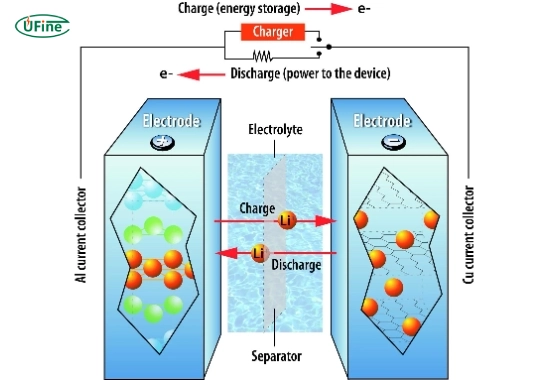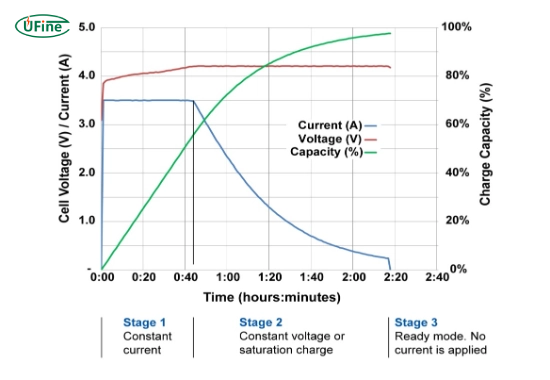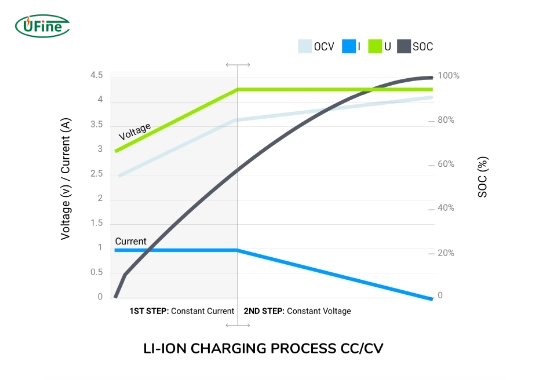Lithium-ion batteries have become an essential part of our daily lives. From powering smartphones and laptops to electric vehicles and renewable energy systems, these batteries offer high energy density, durability, and efficiency. However, one of the most common questions users have is: When is the best time to charge a lithium-ion battery? Proper charging habits not only extend the lifespan of your battery but also optimize its performance. This article will explore everything you need to know about when and how to charge lithium-ion batteries effectively.
Part 1. What is a lithium-ion battery?
A lithium-ion battery is a type of rechargeable battery that stores and releases energy by moving lithium ions between the anode and cathode. These batteries are widely used due to their high energy density, lightweight design, and ability to recharge hundreds or even thousands of times.
Compared to older battery technologies like nickel-cadmium (NiCd) or lead-acid, lithium-ion batteries are more efficient, charge faster, and are less prone to memory effects. However, they require proper care, especially regarding charging, to maintain longevity.
Part 2. Why is proper charging important for lithium-ion batteries?
Proper charging is crucial because lithium-ion batteries degrade over time. Factors like high temperatures, overcharging, or letting the battery discharge completely can accelerate this process. By adopting the right charging habits, you can:
- Extend battery lifespan: Avoiding extreme states of charge (100% full or 0%) reduces battery wear.
- Ensure safety: Prevent overcharging or overheating, which can lead to dangerous conditions.
- Maintain performance: Proper charging habits ensure the battery operates optimally throughout its lifecycle.
Part 3. When should you charge a lithium-ion battery?
The best time to charge a lithium-ion battery is when it reaches around 20-30% capacity. Charging it back up to around 80-90% is ideal for maintaining long-term health. This range prevents excessive stress on the battery’s chemistry, which can occur when it’s fully discharged or charged to 100%.
Key Points to Remember:
- Avoid letting the battery drop below 20%.
- Do not charge the battery to 100% unless necessary (e.g., for long trips).
- Regular partial charges are better than deep discharges followed by full charges.
How to Charge a Lithium-ion Battery?
Part 4. Is it bad to charge a lithium-ion battery overnight?
While modern lithium-ion batteries are equipped with smart charging technology to prevent overcharging, leaving your battery overnight isn’t ideal. When batteries remain 100% for extended periods, the high voltage can stress the cells, leading to faster degradation.
What can you do instead?
- Use a smart plug or timer to limit charging time.
- Unplug the charger once the battery reaches around 80-90% capacity.
- If overnight charging is unavoidable, ensure the device is in a cool environment to prevent overheating.
Part 5. How can you tell if your lithium-ion battery needs charging?
Modern devices often provide battery indicators that show when it’s time to recharge. Here are some general guidelines to help you decide:
- 20-30% charge remaining: This is the ideal time to recharge.
- Low battery warning (typically 10-15%): Recharge as soon as possible to avoid full discharge.
- Below 5%: Avoid letting the battery reach this level frequently, as it can impact overall health.
Part 6. What happens if you overcharge a lithium-ion battery?
Lithium-ion batteries are designed with protective mechanisms to prevent overcharging. However, consistently charging to 100% or leaving the device plugged in for prolonged periods can:
- Increase internal heat, which speeds up wear and tear.
- This causes the battery to retain less charge over time.
- In rare cases, it leads to swelling or safety risks.
Unplug your device once it reaches the desired charge level (around 80-90%) to avoid overcharging.
Part 7. Should you charge a new lithium-ion battery before use?
Yes, it’s a good idea to charge a new lithium-ion battery to around 80-100% before using it for the first time. This ensures the battery is properly calibrated and ready for regular usage. However, there’s no need to “prime” or heavily cycle modern lithium-ion batteries, as they don’t suffer from memory effects like older battery types.
Part 8. Can you use a lithium-ion battery while charging?
Yes, you can use a lithium-ion battery while it’s charging. This is common for devices like laptops and smartphones. However, keep in mind:
- Increased heat: Using the device during charging generates additional heat, which can stress the battery.
- Slower charging speeds: Some devices may charge more slowly when in use.
- Avoid intensive tasks (e.g., gaming or video editing) while charging to minimize wear.
Part 9. Tips for maintaining lithium-ion battery health
To get the most out of your lithium-ion battery, follow these practical tips:
- Charge in the right range: Keep the battery between 20-80% for daily use.
- Avoid extreme temperatures: Lithium-ion batteries perform best in moderate temperatures (20-25°C or 68-77°F).
- Use the correct charger: Always use the charger recommended by the manufacturer to prevent damage.
- Store partially charged: If storing a device long-term, leave the battery at around 50% charge.
- Update firmware/software: Manufacturers often release updates to optimize battery performance and safety.
Part 10. FAQs
-
How often should I charge my lithium-ion battery?
It is best to charge your battery when it exceeds 20-30% capacity. Frequent, more minor charges are better than letting the battery discharge completely. -
Is it okay to charge my battery to 100%?
While it’s not harmful occasionally, regularly charging to 100% can degrade the battery faster. Aim for 80-90% for daily use. -
What’s the fastest way to charge a lithium-ion battery?
Use a high-quality, manufacturer-approved fast charger. Avoid using third-party chargers that may not regulate voltage properly. -
Can I leave my lithium-ion battery plugged in all the time?
Modern batteries have safeguards against overcharging, but leaving them plugged in constantly at 100% can still reduce lifespan. Unplug when the charge reaches 80-90%. -
Do lithium-ion batteries have a memory effect?
Lithium-ion batteries do not suffer from memory effects like older NiCd batteries. You can safely recharge them at any level without affecting capacity.
Related Tags:
More Articles

How to Choose the Best Floor Scrubber Battery for Commercial Cleaning?
Selecting the ideal floor scrubber battery ensures a long runtime, rapid charging, and minimal maintenance for efficient commercial cleaning operations.
Battery for Blower vs Battery for Leaf Vacuum: Which One Should You Choose?
Battery for blower vs leaf vacuum—learn the key differences in power, fit, and runtime to choose the right battery for your outdoor tool needs.
How to Choose the Right Battery for Blower?
Choosing the right blower battery? Consider voltage, capacity, chemistry & usage. This guide helps match the best battery for peak performance.
How to Choose the Best Insulated Battery Box for Lithium Batteries?
Choosing the Best Insulated Battery Box for Lithium Batteries? Discover key factors such as size, material, and safety for optimal protection and performance.
7 Critical Elements on a Lithium Battery Shipping Label
What must be on a lithium battery shipping label? Learn 7 key elements to ensure safety, legal compliance, and correct handling across all transport modes.






